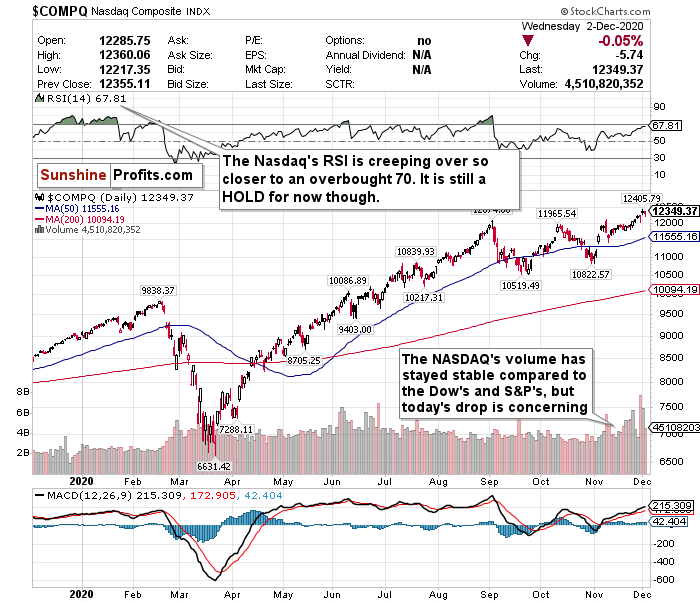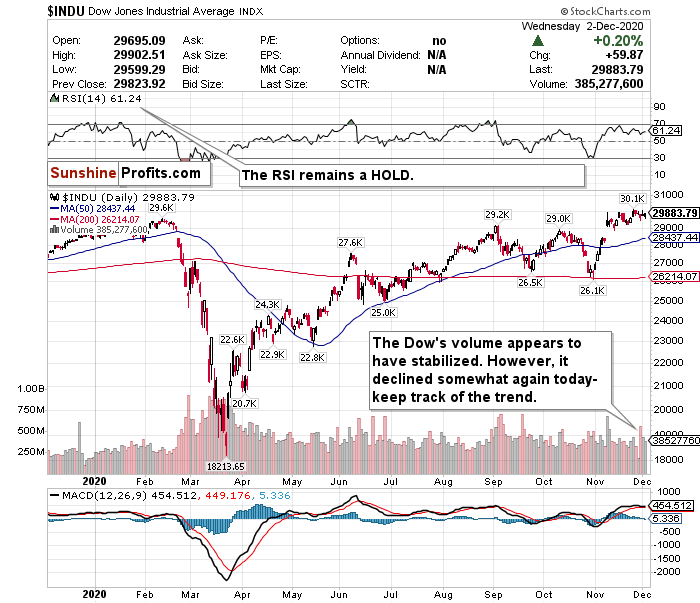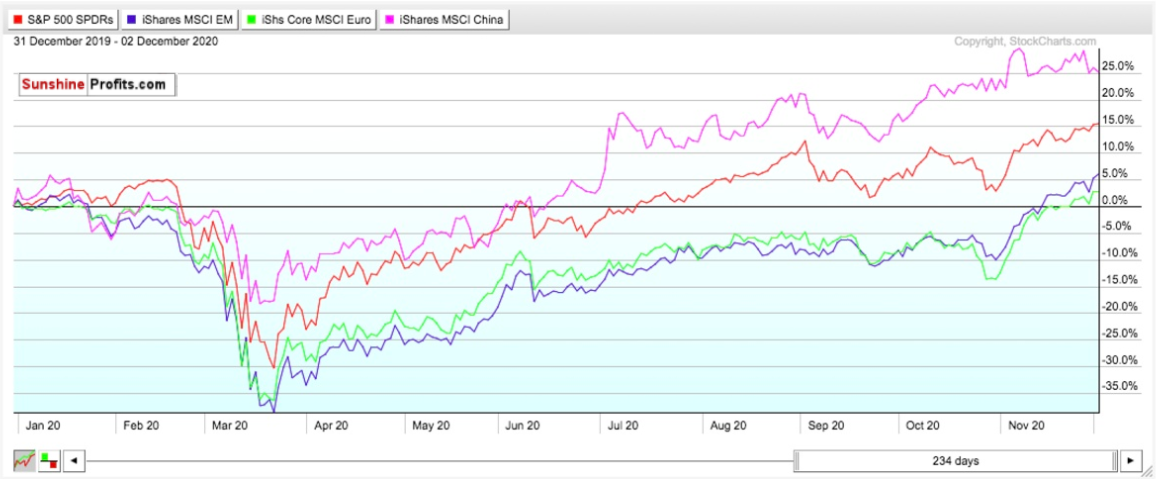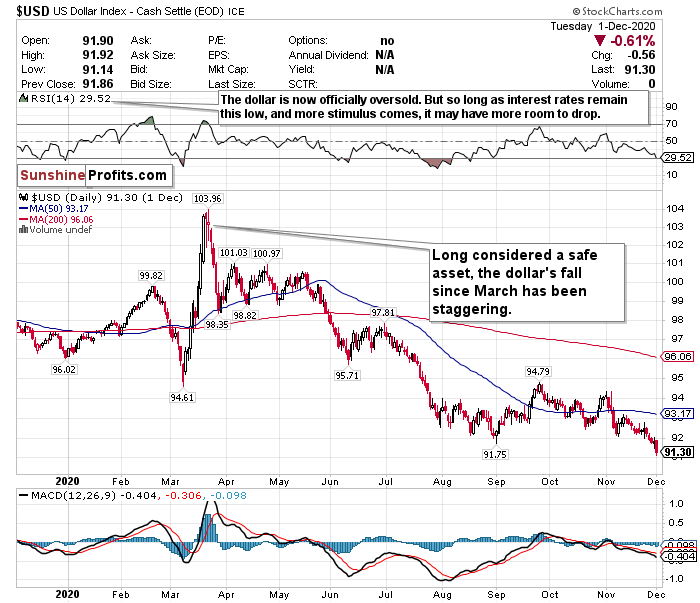As investors weighed the latest vaccine news, stimulus progress, and economic data, the S&P 500 eked out another gain on Wednesday and closed at a record high for a second day in a row.
News Recap
- The Dow Jones climbed 59.87 points, or 0.2%, the S&P 500 gained .18%, and the Nasdaq fell 0.1%.
- Senate Majority Leader Mitch McConnell’s rejection of a bipartisan $908 billion stimulus proposal weighed on stocks and muted gains.
- Despite the positive vaccine data from today, with the UK becoming the first country to approve the usage of Pfizer and BioNTech’s vaccine, Federal Reserve Chairman Jerome Powell called the economic outlook “extraordinarily uncertain” yesterday.
- November’s private payroll data disappointed today and missed expectations. Economists expected 475,000 private jobs to be added in November. However, according to ADP, only 307,000 were added. This was also the lowest figure since July.
- The US reported 180,083 new Covid-19 cases- the most in four days and up from 157,901 the day before. 2597 people also died - the second-highest daily rate on record. Hospitalizations also continue to hit records with at least 98,691 beds occupied on Tuesday.
- Energy and financials were the best performing sectors on the S&P 500 today and rose 3.2% and 1.1%, respectively.
- Boeing led the Dow higher with a gain of 5.1%, while Salesforce lagged by nearly 9% after it confirmed its $27.7 billion acquisition of messaging platform Slack.
Because of the short-term tug of war between optimism and reality, it is fairly difficult to proclaim BUY or SELL calls for the near-term future. Rather, in the short-term, I feel more comfortable staying neutral and calling HOLD for broader markets. There will be optimistic days where investors rotate into cyclicals and value stocks, and more pessimistic days where investors run towards “stay-at-home” names and COVID winning tech stocks. Broader market selloffs could always happen as well.
In the mid-term and long-term, however, there is certainly a light at the end of the tunnel. Once this pandemic is finally brought under control and vaccines are mass deployed, volatility will surely stabilize, and optimism and relief will permeate the markets. The UK’s approval of Pfizer and BioNTech’s vaccine on Wednesday was a huge step forward on that front.
It is a simple fact - markets will continue to wrestle with the negative reality on the ground and optimism for an economic rebound in 2021. Today’s muted and mixed moves should be more of the new normal than the March crash or November surge. Any short-term moves upwards or downwards should be relatively modest and tame. There is still too much pushing and pulling between bad news and good news to say with conviction that another crash or surge will come. If anything, this tug of war will keep markets relatively sideways.
Therefore, to sum it up:
While there is long-term optimism, there is short-term pessimism. A short-term correction is very possible. But it is hard to say with conviction that a big correction will happen.
Tech Valuations are Concerning...But Investors May Be Returning
Although tech and stay-at-home stocks largely lagged behind cyclicals and value stocks during the initial vaccine rallies of November, this rotation appears to have stabilized. The NASDAQ outperformed both the Dow and S&P last week and closed out November with higher gains than the S&P 500. Despite closing the day with modest losses, NASDAQ also had a record close on Tuesday.
Most importantly, this index has shown more stable volume compared to the Dow and S&P. However, Wednesday’s sharp decline in volume is somewhat concerning. If this becomes a trend, it may be more alarming due to the sky-high valuations for many tech stocks.
On pessimistic days, having NASDAQ exposure is certainly a good thing because of all the “stay-at-home” stocks that trade on the index. However, positive vaccine news always induces the risk of downward pressure on tech names- both on and off the NASDAQ.
Because there is a lot of mixed sentiment for tech names, the NASDAQ also gets a HOLD call. Its RSI value of 67.81 is creeping closer towards the dreaded overbought 70 level. While an RSI of 70 doesn’t automatically mean that the trend will reverse, it is something to take note of. If “stay-at-home” names rally again over the course of the next few sessions, the RSI could officially overheat past overbought levels. Just tread lightly.
For an ETF that attempts to directly correlate with the performance of the NASDAQ, the Invesco QQQ ETF (QQQ) is a good option.
The Dow May Be Stabilizing
The Dow Jones may be the major index most vulnerable to news and sentiment at this time. The call on the Dow is also a HOLD, and the index may have stabilized.
The RSI remained firmly in hold territory and is further away from overbought levels, especially compared to The Nasdaq. The Dow’s volume has appeared to stabilize as well, but it did decline somewhat yesterday.
Despite the optimistic vaccine data, on pessimistic “sell the news” kinds of days, the Dow will have short-term downside pressure. This index is composed of many cyclical stocks that are dependent on a strong economic recovery, and any change in sentiment can adversely affect the performance. But similarly to the call on the S&P, it’s hard to say with conviction that a drop in the index will be strong and sharp relative to the gains since March, let alone November. Everything that I see tells me that we could be in a sideways pattern for the near-term. For an ETF that attempts to directly correlate with the performance of the Dow, the SPDR Dow Jones ETF (DIA) is a strong option.
Small-caps Owned November...Where Do They Go From Here?
The Russell 2000 small-cap index saw mild gains on Wednesday. However, since November, this index has outperformed all the others. Just look at how the iShares Russell 2000 ETF (IWM) compares to the ETFs tracking the Dow, S&P, and Nasdaq in that time frame. Since November, the Russell has risen over 19%. This is nearly 6-7% higher than all the other major indices. Much of this can be attributed to the amount of cyclical stocks in the index that are dependent on the recovery of the broader economy.
Although the Russell was relatively muted yesterday, if the last 9 months have shown us anything, it’s that Russell stocks will surge on optimistic days, and drop more on pessimistic days. In the long-term, however, small-caps may be the best opportunity to bet on an economic recovery in 2021. However, in the short-term, small-cap stocks may be the most volatile of them all and are a HOLD.
Mid-Term
China is the Best Bet in Emerging Markets Over the Mid-Term
Investors remain bullish on emerging markets for both the short-term and medium-term. However, performance in the short-term really depends on the region. China, for example, is by far the largest presence in emerging market indices, although it lagged significantly behind other global indices in November. This could very well change in December, but it’s important to note that geopolitical headwinds are beginning to return. Earlier in the week, Reuters reported on the possible blacklisting of a few Chinese companies, and on Wednesday, President-elect Biden said that he would not remove tariffs on China - at least not in the early phases of his administration.
But look at the returns from December 31, 2019 to today and compare the performance of the iShares MSCI China ETF to the iShares MSCI Emerging Markets ex-China ETF, SPDR S&P ETF, and iShares Core Europe ETF. The comparison is staggering. The closest ETF that compares to the China ETF is the SPDR S&P ETF - and the China ETF outperformed that by nearly 10%. Additionally, the Europe ETF and Emerging Markets ex-China ETF have only now broken past the flat line in that same time frame.
China has handled the pandemic better and continues to demonstrate its ability to handle COVID-19’s economic shocks. In fact, China’s GDP has managed to grow from where it was at this point last year - despite its record plunge at the start of the pandemic.
For broad exposure to Emerging Markets, you will want to BUY the iShares MSCI Emerging Index Fund (EEM), for exposure to China you will want to BUY the iShares MCHI ETF (MCHI), and for exposure to a regional economic power without the geopolitical risks of China, you will want to BUY the iShares MSCI Taiwan ETF (EWT). Consider the iShares MSCI Indonesia ETF (EIDO) as well for another growing regional economy.
….and the Dollar May Have More Room to Fall
The US Dollar continued its record plunge yesterday. The dollar is now at its lowest level in 7-months, and lowest level compared to a basket of currencies in over two years. The dollar’s plunge in excess of 10.5% since peaking in March has been staggering.
Many believe that the dollar could fall further as well due to a multitude of headwinds.
If the world returns to relative normalcy within the next year, investors may be more “risk-on” and less “risk-off.” Which means that the dollar’s value will decline further.
Additionally, because of all of the economic stimulus that has been pumped into the markets to this point combined with record low-interest rates, the dollar’s value has been hurt and could be further hurt. Remember, the Fed does not plan on raising interest rates for at least another 2 years. This is an eternity for the dollar’s value. Strategists at Goldman Sachs predict a further 6% decline over the next 12 months, ING analysts forecast as much as a 10% drop, and most notably, Citigroup predicts a shocking 20% drop in 2021.
As the world’s reserve currency, this plunge in value is concerning both in the short-term and mid-term for the US economy. A declining dollar means the strengthening of other foreign currencies such as the Yen or Yuan. Although US Treasuries have somewhat recovered, this could mean bad things for their values as well.
The plunge of the dollar has been so severe that it is currently trading below both its 50-day and 200-day moving averages. Furthermore, its 200-day moving average is considerably higher than its 50-day, further illustrating the sharp decline.
While the dollar may have more room to fall, according to its RSI, it is now officially oversold. This MAY be a good opportunity to buy the world’s reserve currency at a discount. But I just have too many doubts on the effects by such low interest rates, government stimulus, strengthening of emerging markets, and inflation to be remotely bullish on the dollar’s prospects over the next 1-3 years.
For now, where possible, HEDGE OR SELL USD exposure.
Pay Very Close Attention to Inflation
Pay very close attention to the possible return of inflation within the next 6-12 months. The Fed has said it will allow the GDP to heat up, and it may overshoot in the medium-term as a result. Although JP Morgan and Goldman Sachs have cut their GDP growth estimates for Q1 2021, pay close attention to what happens in Q2 and Q3 once vaccines begin to be rolled out on a massive scale. It is only inevitable that inflation will return with the Fed’s policy and projected economic recovery by mid-2021.
If you are looking to the future to hedge against inflation, look into TIPS, commodities, gold, and potentially some REITS.
In the mid-term, I have BUY calls on the SPDR TIPS ETF (SPIP), the Invesco Optimum Yield Diversified Commodity Strategy No K-1 ETF (PDBC), the SPDR Gold Shares ETF (GLD), and the iShares Cohen & Steers REIT ETF (ICF).
Long-Term
While the surging spread of COVID-19 and resulting economic shutdowns may drive some short-term concerns, the progress made on the vaccine/treatment front poses significant optimism for 2021 and beyond. The UK’s approval of Pfizer and BioNTech’s vaccine candidate should be cheered by long-term investors everywhere. Although private payrolls underwhelmed yesterday, and jobless claims underwhelmed last week for the second week in a row, the long-term outlook for equities, namely value stocks, and cyclicals, could be very positive.
Summary
December has started and we are thankfully in the home stretch of 2020. This has been a year filled with turmoil and pain, that will hopefully end with significant optimism. However, COVID-19 will not disappear before 2021 starts, and may be here with us a little bit longer. If November showed us anything though, it showed us that there is finally a light at the end of the tunnel.
Please keep in mind that markets are forward looking instruments and are investment vehicles that look 6-12 months down the road. However, it is very plausible that there could be some short-term uncertainty and volatility mixed in. But please remember how sharp and swift the rally was after the crashes in March. Since the markets bottomed on March 23rd, the Nasdaq is up 84%, the S&P is up 66%, and the Dow is up around 63%. In the long-term, markets always move up, and are focused on the future rather than the present.
Wednesday’s news from the UK was very encouraging. But can this vaccine be scalable to reach billions of people worldwide by springtime?
If everything goes well with the vaccines, and the virus can be somewhat contained, the short-term volatility may be worth monitoring for opportunities before the eventual mid-term and long-term reality turns positive and stable in 2021.
To sum up all our calls, in the short-term I have a HOLD call for:
- the SPDR S&P ETF (SPY),
- Invesco QQQ ETF (QQQ),
- SPDR Dow Jones ETF (DIA), and
- iShares Russell 2000 ETF (IWM).
However, I am more bullish for these ETFs in the long-term.
I suggest avoiding the US Dollar in the mid-term and gaining exposure in the emerging markets.
I have BUY calls on:
- The iShares MSCI Emerging Index Fund (EEM),
- the iShares MSCI China ETF (MCHI),
- the iShares MSCI Taiwan ETF (EWT), and
- the iShares MSCI Indonesia ETF (EIDO)
Additionally, because I foresee inflation returning as early as mid to late 2021…
I also have BUY calls on:
- The SPDR TIPS ETF (SPIP),
- the Invesco Optimum Yield Diversified Commodity Strategy No K-1 ETF (PDBC)
- the SPDR Gold Shares ETF (GLD), and
- the iShares Cohen & Steers REIT ETF (ICF)
Thank you.
Matthew Levy, CFA
Stock Trading Strategist








